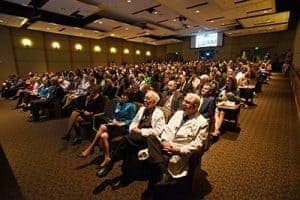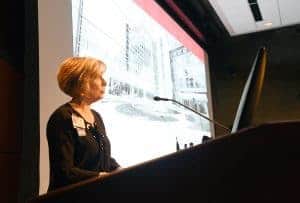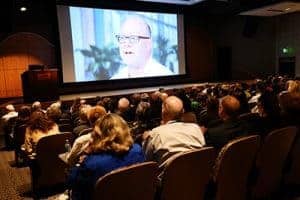Gardner Reports on State of the University
| April 19, 2018 | Interim Chancellor Stephanie Gardner, Pharm.D., Ed.D., discussed the challenges and successes of the past year as she delivered her State of the University address April 17.

UAMS employees packed the Fred W. Smith Auditorium in the Jackson T. Stephens Spine & Neurosciences Institute for the State of the University address.
Employees filled the UAMS Jackson T. Stephens Spine & Neurosciences Institute’s Fred W. Smith Auditorium, with others standing along the wall or seated across the hall in the Hamlen Boardroom. Off campus, employees at 30 sites watched the presentation via a videoconference feed.
Gardner addressed this year’s financial difficulties that led to the Jan. 8 reduction in force (RIF) in which 600 positions were eliminated, including 258 that were filled. An additional 124 positions will be eliminated through attrition as employees retire or quit.
“I have been at UAMS for almost 27 years and [January’s] reduction in force was without a doubt the saddest and most awful time I have ever experienced at this institution,” she said, adding that the situation was “painful for everyone — for the employees who lost their jobs, their families and for everyone who worked with those affected.”
She shared a variety of ways that UAMS has been assisting those workers who were displaced, including two job fairs that were held to assist them in finding new jobs. Employees who were part of the RIF are given priority consideration in applying for new positions at UAMS, and 29 such employees have been rehired.
Earlier in fiscal year 2018, UAMS was facing a $72 million deficit. As of March, UAMS was within $1.7 million of its original projected budget, which means that more than $30 million has been eliminated since the fall.
UAMS is also weeks away from submitting to the University of Arkansas Board of Trustees a budget for FY 2019 without a projected deficit, Gardner said, a feat that hasn’t been accomplished in years.
She cautioned that UAMS isn’t out of the woods yet. Deferred maintenance needs and physical plant challenges, along with reliance on patient care revenue to subsidize educational and research missions continue to be areas of fiscal concern, but the situation is much improved.
“I want to thank everyone here for what you have done to help make that happen,” she said. “That doesn’t happen in one office or several offices. It happens because everyone pulls together.”

Leanne Lefler, Ph.D., president of the Academic Senate, introduces Gardner at the State of the University address. Both the Academic Senate and House of Delegates helped with the event.
Despite the year’s fiscal challenges, there was still a lot of good news to report, Gardner said. She pointed to the Higher Learning Commission’s decision to grant UAMS reaccreditation for 10 years — the longest timeframe it can award.
UAMS also can boast the creation of five new programs, she said, including an M.S. and Ph.D. in Biomedical Informatics (College of Medicine); graduate certificates in Healthcare Analytics and Healthcare Management (College of Public Health); a Radiation Oncology Residency program (College of Medicine); and an Occupational Therapy doctoral program (College of Health Professions), which is a joint program between UAMS and the University of Arkansas at Fayetteville that hopes to accept its first students in 2019.
We continue to produce the health care professionals of Arkansas, she said. UAMS ranks third in the nation at retaining medical school graduates in the state. Nearly 60 percent of practicing physicians in Arkansas graduated from UAMS, and 71 percent of practicing pharmacists in the state were trained here.
The impact of Regional Campuses on physician numbers in Arkansas cannot be understated. Those campuses have trained nearly 800 residents in 129 communities around the state. And 64 percent of residents trained in regional programs have remained in Arkansas to practice.
On the research front, $170 million in funding was secured in FY 2017 for UAMS researchers at UAMS, the VA and Arkansas Children’s Hospital. In the first six months of FY 2018, UAMS researchers brought in $51 million.
“These numbers put UAMS in the top 16 percent of all U.S. colleges and universities in federal research funding,” Gardner said.
Major awards for the year included:
- A $3.5 million Clinical and Translational Science Award (CTSA) was awarded to the Translational Research Institute.
- Charles O’Brien, Ph.D., was the lead investigator on a recent 5-year, $11.3 million COBRE award to establish the Center for Musculoskeletal Disease Research. O’Brien is a professor in the Division of Endocrinology and Metabolism in the Department of Internal Medicine in the College of Medicine.
- A $7 million HRSA grant was awarded to the Arkansas Center for Health Disparities in the College of Public Health.
- Mike Owens, Ph.D., and Brooks Gentry, M.D., received an $8 million grant associated with their work and their BioVentures company InterVexion Therapeutics to fight methamphetamine addiction. Owens is a professor of pharmacology and toxicology and an Arkansas Research Alliance fellow. Gentry is chair of the Department of Anesthesiology.
- An $8.3 million grant from the National Cancer Institute was awarded to expand the national Cancer Imaging Archive, located at UAMS and overseen by Fred Prior, Ph.D., chair of the Department of Biomedical Informatics.

UAMS employees watch a video that highlights the success of the Level One Trauma Center and other programs at the start of the State of the University presentation.
The clinical mission also had a number of highlights for the year, including national certification for UAMS Medical Center as a Level One Trauma Center that sees more than 3,000 patients a year, the installation of cameras on every bed in the NICU and hospital volumes that remain high.
UAMS physicians and nurses continue to be honored, including 32 nurses on the Great 100 Nurses Foundation’s 2018 list and the majority of physicians on the Best Doctors in Arkansas list. Three physicians — Kent Westbrook, M.D., Paul Wendel, M.D., and Ron Robertson, M.D., were recognized as Health Care Heroes this year by Arkansas Business magazine.
Much growth is happening on the regional campuses, she said. The Northwest Regional Campus, which celebrated its 10th anniversary in 2017, now has 236 students, with all five colleges represented. The campus also supports residents from both internal medicine and family medicine.
New family medical centers were opened in Fort Smith and Helena, and one in Batesville will be opening soon.
Gardner concluded her presentation by looking at the road ahead.
“Despite the challenges we have faced and we still face, I believe the future is bright for UAMS,” she said.
Cam Patterson, M.D., M.B.A., will become chancellor June 1. Searches are underway for new deans in the College of Health Professions and the College of Public Health. The search for a new dean for the College of Medicine will begin once Patterson arrives, she said.
She noted that the last year has been a learning experience and a period of growth — professionally, personally and spiritually.
“We have walked this road together, and I have truly appreciated your help, your guidance and your support. But most of all, I appreciate what you do for our students, our patients and their families and for each other.”
